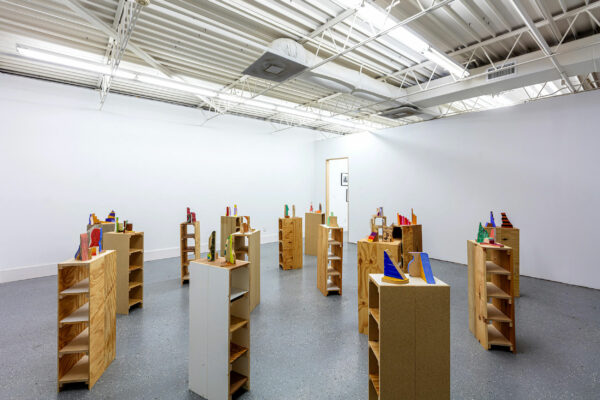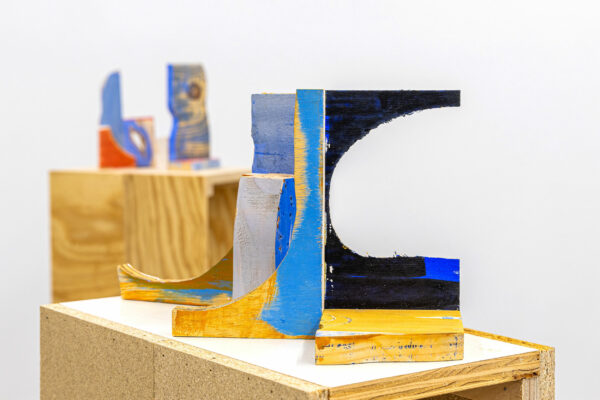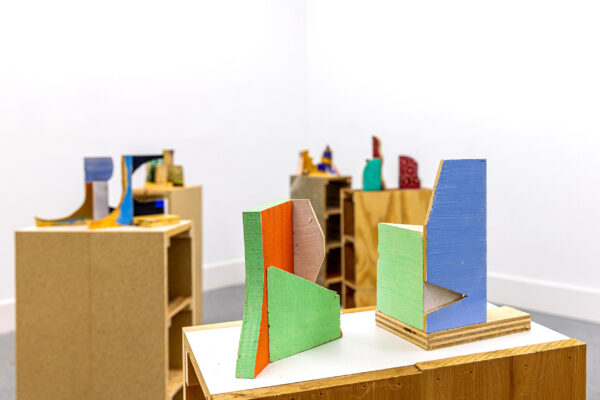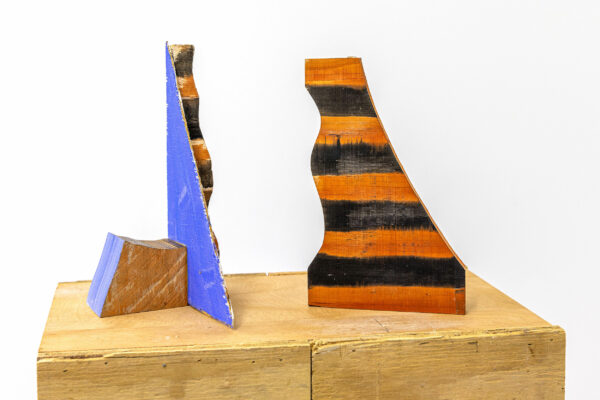
Munro Galloway, “Bookends #21,” 2022, found wood, acrylic paint, dimensions variable. Photo: Alex Barber
A work of art does not stand on its own. Artists rely on the support of communities, curators, collectors, art handlers, art spaces, walls, pedestals, hardware, the laws of physics, social media, reviews, discourse, etc., to present their work and develop their practice. Munro Galloway and Molly Zuckerman-Hartung lean deeper into these questions of interdependency, mutuality, and interconnection at the core of artmaking in their irreverent, honest, and moving two-person show, Bookends, at Basket Books & Art in Houston, which is curated by Edwin Smalling, one of the store’s proprietors.
This multifaceted exhibition is comprised of sixteen artist pedestals that are scattered around the space, designed by Zuckerman-Hartung and fabricated by Smalling using scrap and found materials. Atop each pedestal rests a pair of small wooden bookends, assembled and painted by Galloway. The pairs of bookends take on numerous strange and wonderful forms, relating to each other in shape, color, texture, and scale. Downstairs there are copies of a book designed by Smalling with an essay by Zuckerman-Hartung. These books are presented similarly to the pedestals — they stand upright and are dispersed like a group of islands. Zuckerman-Hartung’s essay is a work of art and a companion to Galloway’s bookends. The pedestals, the bookends, and the essay all depend on each other for their collective meaning.

Installation view of “Bookends,” with pedestals designed by Molly Zuckerman-Hartung and fabricated by Edwin Smalling, and bookends by Munro Galloway, at Basket Books & Art. Photo: Alex Barber
As always, the timing and conditions of making matters. Coming out of the pandemic, Galloway started collecting sluff — castoffs and other wasted bits and pieces from his students’ failed projects — and assembling them into small, paired forms. From their initial conception, these bookends were always about relationships and dependency. As Zuckerman-Hartung writes in her essay, “the teacher borrows from the student, and also reveals a path the student has not yet learned to value.” The relational dynamics between the bookends are akin to symbiosis, where each one benefits from the presence of another.

Munro Galloway, “Bookends #8,” 2021, found wood, acrylic paint, dimensions variable. Photo: Alex Barber
It is a rare thing for an artist to transform an object in such a way that it changes my perception of similar objects I encounter day to day. For example, there is a square rock on the median of I-45 near downtown — balancing precariously — and I often wonder if Jamey Hart placed it there. I will never see boats, bridges, or shadows on the side of a building without thinking of Ellsworth Kelly. Those tiered gray-green or bright blue utility boxes that are all over gardens in Houston always make me think of Ben Peterson’s sci-fi ceramic forms. Unusually shaped sections of Styrofoam often remind me of my grandfather’s (Alexander Welsh’s) self-described “junk art” — never sold or shown publicly — that lined the walls of his home. Much in the same way, the works in this show have all have left indelible marks in my mind, creating a different kind of dependency for me, based on time and memory.
Scraps, sluff, cut-offs, leftovers, trash, waste, and refuse — the primary materials used in this exhibition — have an inherent capacity to generate new work. They provide a surface to bounce off, respond to, and work from, forming new relationships based on historical information and language. The pedestals, bookends, and essay in this show all have the capacity to hold, carry, support, store, catalog, and relate.

Munro Galloway, “Bookends #11,” 2021, found wood, acrylic paint, dimensions variable. Photo: Alex Barber
There is an intrinsic connection between visual art and writing, and Zuckerman-Hartung is a master of both. Her paintings and writing have changed the way that I think about language — from her solo show and visual thesis at the Blaffer Art Museum, to this exquisite two-person show at Basket. Zuckerman-Hartung’s writing for this show is vulnerable, honest, angsty, metaphorical, murky, and potent. It is the perfect pairing for Galloway’s challenging, poetic, and beautiful bookends. I admire the lyrical nature of her writing, and the associations she draws upon, both personal and universal. In the final section of her essay, where Zuckerman-Hartung connects the bookends to sailboats, she writes, “let the wind blow through.” As with any relationship, the negative space between the bookends is an essential aspect of their connection to each other.

Munro Galloway, “Bookends #12,” 2021, found wood, acrylic paint, dimensions variable. Photo: Alex Barber
I love this show because it is a reminder that we can imagine, support, build, and sustain an art world that embraces healthy dependency, positive relationships, mutual collaboration, and generative discourse. We work with what we have, and it can be spectacular.
Copies of Bookends, which has an essay by Molly Zuckerman-Hartung and is designed by Edwin Smalling, are available for purchase at Basket Books & Art. The exhibition is on view through December 2, 2023.


